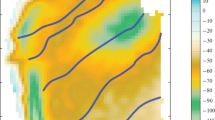Abstract
The approach, fundamentally different from the known ones, to estimating the spatial location of the domain filled with the disturbing masses based on the gravity field measurement data is suggested. The main idea of the approach is, using the set of the probable variants of the interpretation, to construct the distribution of a certain parameter associated with the estimate of probability of detecting the sources of the field in any point of the studied geological medium and then to apply this distribution to each domain eligible for being the true carrier of the anomalous masses. These constructions yield the generalized admissible solutions of the inverse problem with ranking the separate fragments of the model carrier in terms of the probability of detecting anomalous masses in them.
Similar content being viewed by others
References
Aizerman, M.A. and Malishevskii, A.V., General theory of best variants choice: some aspects, Avtom. Telemekh., 1981, no. 2, pp. 65–83.
Arnold, V.I., Topological problems of the theory of wave propagation, Russ. Math. Surv., 1996, vol. 51, no. 1, pp. 1–48.
Balk, P.I., On reliability of the results of quantitative interpretation of gravity anomalies, Izv. Akad. Nauk SSSR, Ser. Fiz. Zemli, 1980, no. 6, pp. 65–83.
Balk, P.I., The use of the a priori information about the topological features of the sources of the field in the solution of the inverse problem of gravimetry, Dokl. Akad. Nauk SSSR, 1989, vol. 309, no. 5, pp. 1082–1084.
Balk, P.I., A priori information and admissible complexity of the model of anomalous objects in the solution of inverse problems of gravity, Izv., Phys. Solid Earth, 2013, no. 2, pp. 165–176.
Balk, P.I. and Dolgal, A.S., Inverse problems of gravity prospecting as a decision-making problem under uncertainty and risk, Izv., Phys. Solid Earth, 2017, vol. 53, no. 2, pp. 214–229.
Balk, P.I., Dolgal, A.S., Balk, T.V., and Christenko, L.A., Finite-element technologies of interpretation of gravity data. Assembly method, Geofiz. Issled., 2012, vol. 13, no. 3, pp. 18–34.
Cheremisina, E.N and Nikitin, A.A., Sistemnyi analiz v prirodopol’zovanii (Systems Analysis in Natural Resources Management), Moscow: VNIIGeosistem, 2014.
Chernous’ko, F.L., Optimal guaranteed estimates of uncertainties with the use of ellipsoids. Part 1, Izv. Akad. Nauk SSSR, Tekh. Kiber., 1980, no. 3, pp. 3–11.
Dolgal, A.S. and Sharkhimullin, A.F., The increase of the interpretation accuracy for monogenetic gravity anomalies, Geoinformatika, 2011, no. 4, pp. 49–56.
Dolgal, A.S., Balk, P.I., Demenev, A.G., Michurin, A.V., Novikova, P.N., Rashidov, V.A., Khristenko, L.A., and Sharkhimullin, A.F., The finite-element method application for interpretation of gravity and magnetic data, Vestn. KRAUNTs, Nauki Zemle, 2012, vol. 1, no. 19, pp. 108–127.
Gol’tsman, F.M., Problem questions of informational-statistical theory of interpretation of geophysical measurements, Izv. Akad. Nauk SSSR, Fiz. Zemli, 1977, no. 12, pp. 75–86.
Gol’tsman, F.M. and Kalinina, T.B., Statisticheskaya interpretatsiya magnitnykh i gravitatsionnykh anomalii (Statistical Interpretation of Gravity and Magnetic Anomalies), Leningrad: Nedra, 1983.
Nikitin, A.A., Determinacy and probability in processing and interpretation of geophysical data, Geofizika, 2004, no. 3, pp. 10–16.
Raiffa, H., Decision Analysis: Introductory Lectures on Choices under Uncertainty, Reading, MA: Addison-Wesley, 1968.
Starostenko, V.I., Ustoichivye chislennye metody v zadachakh gravimetrii (Stable Numerical Methods in the Problems of Gracvimetry), Kiev: Naukova dumka, 1978.
Strakhov, V.N., Geophysics and mathematics, Izv. Akad Nauk, Fiz. Zemli, 1995, no. 12, pp. 4–23.
Strakhov, V.N. and Lapina, M.I., Assembly method for solving the inverse problem of gravimetry, Dokl. Akad. Nauk SSSR, 1976, vol. 227, no. 2, pp. 344–347.
Zienkiewicz, O., The Finite Element Method in Engineering Science, London: McGrow-Hill, 1971.
Author information
Authors and Affiliations
Corresponding author
Additional information
Original Russian Text © P.I. Balk, A.S. Dolgal, 2018, published in Fizika Zemli, 2018, No. 2, pp. 189–204.
Rights and permissions
About this article
Cite this article
Balk, P.I., Dolgal, A.S. Generalized Solutions of the Inverse Problem and New Technologies for the Quantitative Interpretation of Gravity Anomalies. Izv., Phys. Solid Earth 54, 372–387 (2018). https://doi.org/10.1134/S1069351318020027
Received:
Published:
Issue Date:
DOI: https://doi.org/10.1134/S1069351318020027




